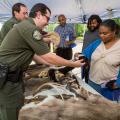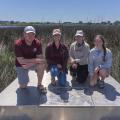Discouraging Deer in the Garden
Discouraging Deer in the Garden
The populations of white-tailed deer have risen dramatically in the eastern United States in recent years. In addition to abundant deer, many have expanded their range and seem well suited to living in rural and even urban residential areas. Deer are opportunists, and will feed upon over 700 species of plants. Unfortunately, many of these preferred plants are food crops or ornamental plants that are often grown in gardens. Deer will feed heaviest in late spring, summer, and fall; adult deer will consume an average of 6 to 10 pounds of food per day.
There are a number of methods available to discourage deer from an area, each with varying levels of effectiveness. By far the use of fencing is the most effective long-term solution to preventing deer damage. Although deer can jump fences exceeding ten feet in height, most of the time they prefer not to, and a height of eight feet is usually sufficient. It is suggested that the fences to be electrified, to be kept clear of vegetation at least six feet from the fence, and to have the bottom strand no more than six inches from the ground.
Repellents
A number of repellants are commercially available that are advertised to repel deer. Repellants work by either having a bad taste or odor to the deer. Although most work in the short term, they often must be applied to the target plants on a regular basis. There are many types of repellants including human hair, mothballs, bloodmeal, soap, and commercial chemicals. These should be rotated in usage regularly and applied every 3-4 weeks. The cost effectiveness of this measure is best when the area of application is small and easily accessible.
Dogs
While effective, the use of dogs to deter deer has limited applications. Most residential areas have leash laws for dogs and prohibit them from running at large. Even with the use of electric invisible fences to contain dogs, not all dogs will respect an electric fence when pursuing a deer or other wildlife.
Selecting Plants that Deer Dislike
Another method to reduce deer damage in prone areas is to choose plants that deer do not like. Studies have shown that there are plants that are preferred by deer and some that are generally disliked. Hungry deer will eat almost anything and prefer young tender plants to older tougher shoots. Preferred deer plants include fruit trees such as apples, pears, and plums; cedars and arborvitae, viburnum, birch, dogwood, daylilies, hostas, hydrangea, and yews. Many popular ornamental annual and perennial plants (because they are usually tender and succulent) are very susceptible to deer browsing.
Plants that have been observed to be rarely damaged in the landscape by deer browse, include: (Source: Cornell University)
| TREES American holly Leucothoe European beech Honey locust Austrian pine PERENNIALS Yarrow Ornamental chives and onions Wormwood Butterfly weed Astilbe Painted and Shasta daisy Feverfew Coreopsis Sweet William Purple coneflower Joe-pye weed Mint Bee balm Daffodil Ferns Sage Soapwort Goldenrod Tansy Vinca |
SHRUBS |
Publications
News
An underserved community spent a day enjoying the outdoors at the Sam D. Hamilton Noxubee National Wildlife Refuge in early May as Mississippi State University Extension Service personnel hosted 20 adult residents of care homes.
Jim McAdory, MSU Extension agent in Winston County, coordinated the May 1 event with help from several other Extension agents and U.S. Fish and Wildlife Service staff. The goal was to allow this population to experience the outdoors, complete with a hot dog lunch at the end of the event.
PICAYUNE, Miss. -- School groups, nature enthusiasts and the public can enjoy two fun-filled days of exciting, hands-on learning about the environment, ecosystems, wildlife and insects at the Mississippi State University Crosby Arboretum in Picayune. BugFest offers insect-related displays, interactive exhibits, games and crafts. Biologists, naturalists, entomologists and other experts from Mississippi, Louisiana and Alabama will host booths and give presentations on butterflies, bats, caterpillars, beetles, crayfish, ladybugs, hissing cockroaches, dancing praying mantises, native and exotic arthropods and more.
Two conservation camps this summer offer students in grades six through 12 the opportunity to gain hands-on experience in wildlife science, outdoor recreation and conservation careers. Conservation Camp 2022 has a residential edition June 5-8 for rising eighth through 12th graders. The day camp edition is June 13-15 for rising sixth through eighth graders.
Success Stories
More than 80 grade-school students from Choctaw Tribal Schools visited Mississippi State University in March to participate in Choctaw Preview Day.
Robin Whitfield, who gave the child the paper, stands awestruck, watching her friend’s daughter use the flower to draw and color on the page.
Mississippi State University and partners have been awarded a grant of nearly $6.6 million from the National Fish and Wildlife Federation for shoreline restoration work on the Gulf Coast.





